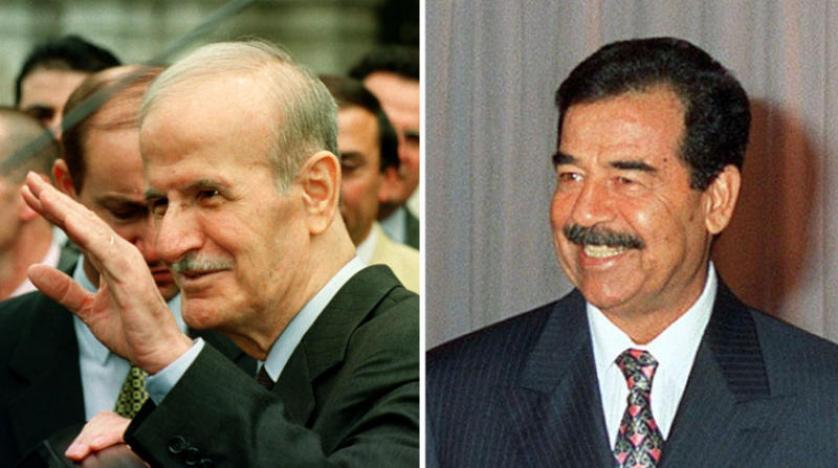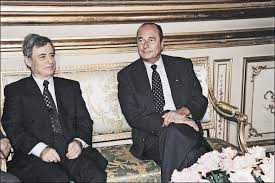In the mid-1990s, then-Iraqi President Saddam Hussein initiated two secret communication channels with his Syrian counterpart, Hafez al-Assad. But the latter had “doubts” about Saddam’s intentions, based on past experiences and his role in thwarting the implementation of the “Joint National Action Charter” between Syria and Iraq in 1979.
Thus, he subjected Saddam to several tests to prepare the ground with the Arab countries and the Iraqi opposition, before making public steps to end the hostility between the Baathist regime in Baghdad and Damascus, by exchanging secret messages, which Asharq Al-Awsat is revealing for the first time.
Those letters are part of the many documents that late Syrian Vice President Abdel Halim Khaddam carried from his office to Paris, when he left Syria in 2005 and announced his defection from the regime at the end of that year. Asharq Al-Awsat contacted the Iraqi envoy, Ambassador Anwar Sabri Abdul Razzaq Al-Qaisi, who confirmed the authenticity of the documents.
In his first letters in August 1995, Saddam was rushing to reopen the two embassies that were closed in 1982, hold high-profile and public political meetings and open the borders. But Assad decided to hold Arab consultations before responding concretely to the Iraqi president’s proposals, in order to ensure “the achievement of the interests of the Arab nation and the two brotherly countries,” according to Khaddam.
In August 1995, Iraqi ambassador, Rafeh al-Tikriti, requested a meeting with Syrian Ambassador Abdulaziz al-Masri, whom he met on the same day and informed that he had received a personal message from his leader, Saddam, to be conveyed to Assad.
The letter read: “I affirm that the step we are taking towards Syria with the aim of building trust and rapprochement between the two countries is very serious, and that any past sensitivity shall not be repeated. The experiences of the past have their own circumstances. We must forget them and start again with open hearts during this dangerous stage.”
In late August 1995, Anwar Sabri Abdul Razzaq Al-Qaisi, the Iraqi ambassador to Qatar, contacted the Director General of the Arab Organization for Agricultural Development, Yahya Bakour, asking him to inform Damascus of his desire to pay a visit with another message from Saddam.
Khaddam recounted: “Assad discussed the two letters with me and Foreign Minister Farouk Al-Sharaa, and decided to agree to the secret presence of the Iraqi ambassador and limit his contacts with me. The concern was to ensure that contacts take place with the Iraqi ambassador in Qatar and not in Ankara, for many reasons, including information security, due to the possibility that the (Syrian and Iraqi) embassies in Ankara were infiltrated by several intelligence services…”
“On September 5, 1995, I received Anwar Sabri Abdul Razzaq in the evening. It was a cordial meeting during which we reviewed the relations between the two countries and the role of Baghdad in disrupting these relations, including the alleged plot in July 1979.”
Khaddam quoted the Iraqi ambassador as telling him: “Warm greetings from the Iraqi president to President Hafez and to you. Saddam stresses that Iraq’s desire to restore normal relations with Syria was not due to the American pressure and an intentional insistence on continuing the siege. Rather, this desire stems from considerations related to Arab national security and fateful interests.”
The ambassador added that Saddam believed that the US-Zionist scheme was evident, and that Jordan had become a part of it.
The scheme aims to harm not only Iraq, but also Syria and all Arab interests, and the goal is not to weaken and divide Iraq, but rather to invade the Arab region politically, militarily and economically, the Iraqi ambassador told Khaddam.
Saddam was also quoted as saying that Iraq seeks, with an open mind and sincere intentions, to hold dialogue with all Arab parties, without exception, in order to clear the air and conclude Arab reconciliation on definite objectives.
Khaddam said: “I presented the letter to President Hafez, and he discussed it with me at length in light of the dark past in the relations between the two countries. Nevertheless, he saw that the answer should be positive and friendly, in which he would ask for a meeting to test the seriousness of the Iraqi position.”
On Sept. 13, 1995, the Syrian vice president received the Iraqi ambassador and told him the following: “President Hafez affirms that the situation the Arab nation is going through and the threats facing Iraq and Syria require the two sides to take the initiative, without delay, to overcome obstacles and differences and stop the deterioration…”
“The main danger is the Jordanian role, which, as we said earlier, has become a major part of the US-Zionist strategy… Therefore, it is important to reinstate normal relations at this particular time between the two brotherly countries – Iraq and Syria – which are capable of building a unified and effective Arab stance to face challenges…”
According to Khaddam, the Iraqi ambassador received the letter with great satisfaction, and seemed very excited for his immediate return to Iraq.
On September 19, the Iraqi ambassador in Ankara met his Syrian counterpart, and informed him that Baghdad had received the Syrian leadership’s response with satisfaction, and that it was up to the Syrian president to determine the nature, level and extent of dialogue and cooperation.
Khaddam recounted: “For us, the situation was worrisome because of the American and Jordanian action on the one hand, and the past experiences with the Iraqi leadership and the bitterness and pain we experienced… Moreover, the rapid rapprochement, without any Arab preparation, will lead to confusion in our Arab relations and tension with the nationalist movement within the Iraqi opposition…”
On Feb. 2, 1996, he received Anwar Sabri, who conveyed a message from Saddam, saying: “The continuation of the siege on Iraq, under the pretext of the country’s non-compliance with international resolutions, is posing more than a challenge… The situation that the Arab nation is currently going through does not constitute a threat to the Arab national security only, but rather to the positions and future of the Arab identity, through the proposals of the Middle Eastern concept, which has become adopted and worked for by more than one Arab country.”
The ambassador added: “President Saddam stresses that what is required of Iraq and Syria, the two pillars of the Arab nation at this stage, is to move quickly and before it is too late, to stop the state of Arab deterioration, through the return of fraternal relations, no matter how deep the differences are… The Arab world is threatened by disintegration, especially if we monitor the recent American statements, which found support from an Arab party that has become part of the American-Zionist scheme, i.e. Jordan. The latter has adopted the idea of establishing a military alliance led by America, in which Israel, Jordan and Turkey assume a role, under the pretext of protecting peace gains…”
According to the minutes of the meeting, the ambassador said: “Despite the positive points achieved in the recent Iraqi-Syrian meetings, President Saddam believes that they are not up to the level of challenges we are facing at this stage. These challengers are represented by the suspicious Jordanian role and the nature of the alliance with the Zionist entity in redrawing the map of alliances in the region.”
Therefore, Saddam, according to the message conveyed by the Iraqi ambassador in Doha, “suggests the need to open the oil pipeline that passes through Syria, and to make technical steps to turn this pipeline into one of the five outlets that Iraq will rely on to export oil during the implementation of the United Nations proposal, or after the lifting of the blockade, as well as for the Syrian ports to be the commercial port of Iraq.”
The Iraqi ambassador continued: “President Saddam urgently suggests the following: Restoring diplomatic relations between the two brotherly countries; initiating political contacts at the highest levels, to determine priorities for the building of relations; launching security talks between the two countries at the level of the chiefs of the security; and opening the borders according to procedures agreed upon by both sides.”
Khaddam said that he conveyed the message to Hafez al-Assad, who was confident that the Iraqi leadership’s proposal was of great benefit to Syria, but at the same time he feared an Iraqi retreat.
He recalled: “I agreed with President Assad to prepare a draft response that would keep the path of dialogue open in order to explore the possibility of reaching a serious agreement on the one hand, and to create a suitable atmosphere, especially with Saudi Arabia and Kuwait, which were the most affected by the invasion of Kuwait and the most sensitive among the Gulf states to this issue, on the other.”
“On Feb. 4, 1996, I submitted the draft letter to the president, who approved it, then summoned the Iraqi ambassador to inform him that Mr. President presents his greetings to his brother President Saddam, expresses his satisfaction with his initiative, and shares his concern about the situation in the region and the conspiracy aimed at dismantling the Arabs and abolishing the Arab identity (…) After King Hussein announced his project, we reached a conclusion that it was in the interest of the Arab nation to make contacts with a number of Arab countries (…) and then we received your initiative. Therefore, in the coming days, contacts will be made with these countries at a high level, with the aim of convincing them of our aforementioned directions.”



